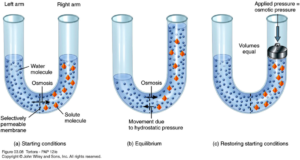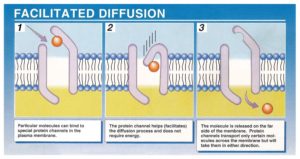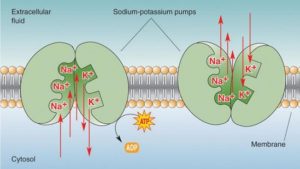Cells (AQA AS Biology) PART 5 of 6 TOPICS
|
Transport across membranes:
The cell membrane of any cell has many features:
- phospholipid bi-layer which allows water and gases to diffuse across but not large molecules
- Glycoproteins and glycolipids act as receptors
- Ion channels allow molecules that are too hydrophilic to go through the lipid bi-layer
- Carrier proteins use energy in the form of ATP to actively transport molecules
- Cholesterol stops the movement of other types of molecules
Many types of transport occur:
Facilitated diffusion involves a carrier protein which has a special binding site for specific molecules. When the molecule is attached the carrier protein changes shape to allow the molecule to go down its concentration gradient on to the other side. As this is diffusion, this always involves certain carrier proteins so the molecules that use this carrier protein always go down their concentration gradient. Channel proteins open when a certain type of molecule binds to its receptors called acetylcholine (NB: This name does not need to be known for the exam, however it is good to know what you are talking about). This channel is called a ligand-gatted ion channel. Ions such as Na+ diffuse down its concentration gradient.
Osmosis is where water molecules move from a high water potential to a low water potential through a semi-permeable membrane (NB: It is important that you say potential and not concentration at AS AQA Level as you will not get the mark. It is important that you say semi-permeable membrane and not just membrane because it does not allow all things to go through only water molecules and gases as you will not get the mark). Solutions that have a higher concentration of solutes than the cell they are surrounding are called hypertonic. Vice versa means that they are hypotonic. If the cell and the solution both have the same concentration of solutes then they are called isotonic with respect to the solution.
Active transport involves ATP being hydrolysed into ADP and Pi. The Pi controls the transport of solutes through another type of carrier protein up its concentration gradient.
Cells may be adapted also to do rapid transport where they have many proteins as part of their cell membrane.



